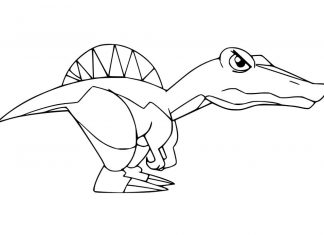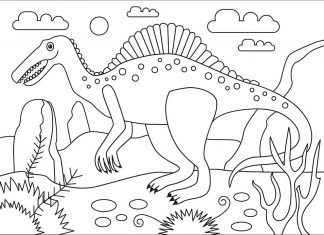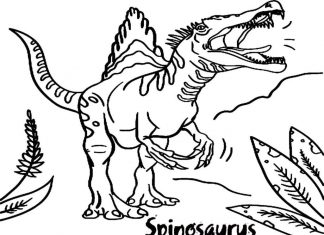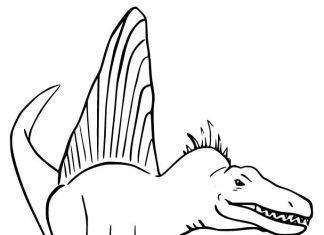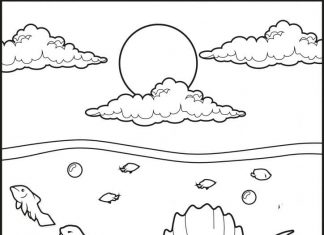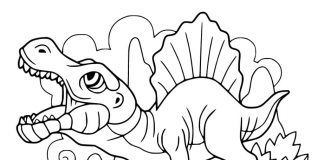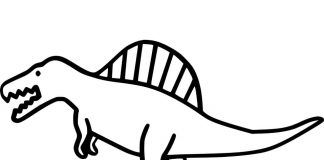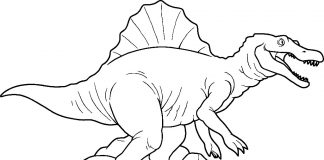Spinosaurus (Spinosaurus) is a giant carnivorous dinosaur that lived during the Cretaceous period, about 112-93 million years ago, in what is now North Africa.
Spinosaurus Coloring Book
information
- resembling a sail, which gave it a unique look.
- Living environment: Spinosaurus inhabited areas of present-day North Africa, around present-day Morocco, Algeria and Egypt. Many researchers believe that Spinosaurus lived mainly in aquatic environments, close to rivers and lakes.
- Diet: From an analysis of its skull structure and dentition, scientists surmise that Spinosaurus was adapted to catching fish. Its long snout and conical teeth suggest that fish were a major component of its diet.
- Life in the water: Research suggests that Spinosaurus may have spent a lot of time in the water, much like crocodiles. Its particularly long, curved snout would have been advantageous for hunting in water.
- Discovery and reconstruction: The first fossils of a Spinosaurus were discovered by paleontologist Ernst Stromer in Egypt in 1912. Although some fossils were destroyed by bombing during World War II, scientists were able to develop reconstructions of this dinosaur based on the available evidence.
- Controversy: A long-standing controversy revolved around the shape of the fin on the spinosaur's back. Initially, it was thought to be a vertical fin, which would suggest that Spinosaurus had an aquatic lifestyle. However, current theories suggest that the fin was horizontal and may have had a thermoregulatory function or was used for communication.
- Pop Culture: Spinosaurus has become one of the more recognizable dinosaurs in pop culture, appearing frequently in books, movies, video games and other media related to paleontology and dinosaurs.
- Research: Although we know more and more about the spinosaurus, there are still many mysteries surrounding this giant dinosaur. Paleontological research is still ongoing to better understand its behavior, habitat and evolution.
trivia
- Flipper on the back: A distinctive feature of Spinosaurus is its large bony fin on its back. It was originally thought to have been a vertical fin, but current theories suggest that it was rather horizontal and may have had thermoregulatory or communication functions.
- Length and weight: Spinosaurus was one of the largest carnivorous dinosaurs. It is estimated that it reached a length of between 15 and 18 meters, and its weight could reach up to 7 tons.
- First reconstruction: Ernst Stromer, a German paleontologist, was the first scientist to discover Spinosaurus fossils in Egypt in 1912. He discovered fragmentary remains, based on which he made the first reconstruction of a dinosaur.
- Life in the water: Because of its long and slender bones, some scientists have speculated that the spinosaurus may have led a partially aquatic lifestyle, similar to crocodiles.
- Dietary diversity: Although Spinosaurus is mainly associated with fish because of its long snout and teeth, research suggests it may also have hunted herbivorous dinosaurs and other animals using its size and strength.
- Competition with other dinosaurs: During the Cretaceous period when Spinosaurus lived, there was a lot of competition between different predator species. Other large predatory dinosaurs from this period were species such as Tyrannosaurus rex and Carcharodontosaurus.
- Influence on pop culture: The spinosaurus has also gained popularity outside scientific circles, appearing in books, movies and video games. A particularly notable appearance was the spinosaurus in the film "Jurassic Park III," where it was one of the main antagonists.
- Incomplete evidence: Many paleontologists realize that much information about Spinosaurus remains speculative, as only fragmentary remains of this dinosaur have been discovered.
- Anatomical studies: With the discovery of new fossils and advanced research techniques, scientists continue to explore the anatomy of the Spinosaurus in an attempt to understand its behavior, mobility and ecology.
- Symbol of paleontology: Spinosaurus has become one of the symbols of the fascinating world of paleontology, reminding us that past eras hold secrets and amazing life forms.


